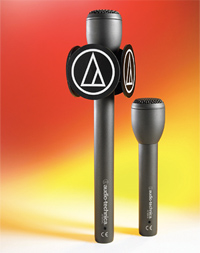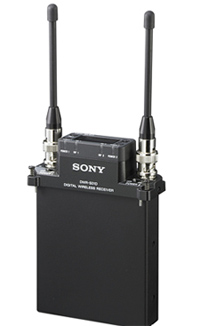Sound Advice for News Audio

AT 8004L
LOS ANGELES
Audio quality is not the only criterion for microphones that are typically found in the television news environment. In a medium that is first and foremost visual, mic products must either be nearly invisible, in the case of the typical onscreen anchor's lavalier mic, or else highly visible, with the ability of the average standup interview mic to prominently display the station's ID flag.
"The longer handle stick mic is really designed to put the station's flag on it," observed Steve Savanyu, director of educational services for Audio-Technica. The company offers a traditional dynamic omni interview mic, the AT8004, in a longer-handled version-the AT8004L-for that very purpose, he says. "One of the things that sets ours apart is that the handle assembly is a lightweight material."
NO HANDS
The interview microphone is probably the only item of audio equipment that makes it onto the TV screen daily. Perhaps the most widely seen interview mic worldwide is the Electro-Voice RE635A and its cousin, the RE50B, a pair of virtually indestructible dynamic omni-directional microphones that have become workhorses of the television news environment.
There is a second reason for a longer handle. "You can hold the base of it and your hand won't be in the shot," said Robb Blumenreder, channel manager for professional products, Sennheiser US. The Sennheiser model most commonly found in TV news and sports interview situations is the cardioid pattern MD46, he added. An omni version, the MD42, is also available.
Shure, Inc. offers two models that find their way into TV news applications, according to Chris Lyons, manager of technical and educational communications. One is the VP64A and long-handled VP64AL version, and the other is the SM63L.
"Those are similar handheld, omni-directional, dynamic mics," he said. "The difference is that the 63 model has a slightly nicer sound quality with a little bit broader frequency response and a better shock mount for lower handling noise."
Lyons has spotted Shure mics on the local news stations: "There are two stations here in Chicago that I see using them all the time. I know that the ABC station here in Chicago, WLS, is a big fan of the 63s."
According to Savanyu, a handheld or a lavalier in the field "might go wired to the camera, or a mult box cable feed back to the truck, or it may go via wireless to a receiver on the cameras or in the truck." Although all the major mic manufacturers offer wireless equipment, not all interview mics are wireless. Many broadcasters have standardized on Lectrosonics or Sennheiser plug-on transmitters, which allow a handheld dynamic interview mic to wirelessly feed the camera or news van.
FOR BIGGER BUDGETS
Sony offers a range of RF products for ENG use, according to senior product manager Karl Kussmaul. "One is the WL800 series that we've had in our product line for many years. It's an analog wireless system that includes a slot-in receiver that can mount directly inside the top of the camera, as well as a plug-on transmitter, and a couple of different variations of body pack transmitters."
More recently, Sony introduced a digital wireless range for ENG. "On the high end of the market that's primarily our focus." The system offers a similar range of transmitters to its analog counterpart.
"We also participate in making lavalier microphones, even for standalone wired microphone use, as well as handheld interview microphones that are used in a wired or wireless configuration," added Kussmaul, noting that organizations such as Louisiana Educational Television, New Hampshire Public Television and Boston's WBAL use Sony mic products.
Sennheiser's camera-mount Evolution Wireless EW100ENG-G3 and EW112P-G3 systems are very popular, while a popular low cost shotgun system is the ME66/K6 combo. "Those are sold by the tens of thousands," said Blumenreder.

Sony DWR S01D digital wireless receiver For those with a bigger budget, the SKM5200 RF handheld provides frequency agility and 7,200 tunable frequencies. "Sennheiser has just recently announced, rather quietly, that we're increasing the switching bandwidth on our transmitters and receivers, from 90 MHz up to 180 MHz," said Blumenreder. "The high-end Sennheiser gear, with two different frequency ranges, will cover the entire available spectrum."
Sennheiser also has a standard shotgun in the market, the MKH 416, that demonstrates another important criterion: reliability. "It's solid, it's metal; you'll have all the paint come off of it before you ever break the microphone! It can handle high humidity and abuse. They get wet, they dry out, they're fine," Blumenreder said.
"Our shotguns are designed to work in some pretty extreme environmental conditions, and even our lav mics will take some pretty good abuse," said Savanyu. "They have to be able to work in any environmental condition-wind, rain, snow. In some ENG applications they'll use a short shotgun, either held by the talent out of camera, or with a boom operator. Our BP873 is a good example, a low-noise shotgun with good off-axis rejection and a good response."
Audio-Technica also offers the camera mounting BP4071 and shorter 4073, with the less expensive AT897 and 875R going into smaller markets and lower budget productions, he added.
Shure lavalier mics show up in broadcast studio applications, said Lyons, most notably the omni WL50 and the cardioid WL51. "Those both go with our wireless packs or other people's body packs," he said.
Audio Technica's AT899 is a 5mm, subminiature, omni-directional condenser microphone. "It comes in a couple of different colors with a plethora of accessories," Savanyu said. "Oftentimes in a news situation they will double-mic the talent, so we have dual mic clips and things of that nature. We also have recently come out with the BP 896, which is a 2.5mm sub-miniature lav."
Sennheiser's MKE 2 lav has long been popular, but the MKE 1, out now for about a year, offers similar audio quality yet has the added ability to blend into the wardrobe. "It comes in black, beige, white and brown," said Blumenreder. "So now there's a nice blend of technology and aesthetics."
Get the TV Tech Newsletter
The professional video industry's #1 source for news, trends and product and tech information. Sign up below.
